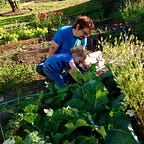The Literal Magic of Fermentation
Crafting a Home for Indwelling Spirits
--
Good food for intestinal bacteria is helpful to our mental condition. For example, 90% of serotonin is produced by intestinal bacteria. Their vital activities produce a good nourishment for the brain and decide our basic mood and energy field.
The animists expect more. ‘How they feel is how we feel.’ Favorable circumstances for intestinal microorganisms decide our openness to the world. Our positive imagination and direction in life is based on our confidence in being on a right track. It is not just a matter of nourishment but of our communication of life energy.
— Kumiko Uchino, New Animism: A Recovery of Ancient Wisdom for Global Harmony
Let’s make some “Poor Man’s Cheese.”
Keckek el fouqara, one of the simplest fermentations around, first came to my attention via a friend who found the recipe in one of Sandor Katz’s books. To make this creamy, tangy, delicious, spreadable treat, first we mix 2 parts bulgur wheat with 3 parts water and a teaspoon of salt. We cover it with cheesecloth and leave it in a warm place. Every few days, we stir it up and press the bulgur wheat under the brine. Repeat for 3–5 weeks.
After the initial couple of weeks, you can take off the cheesecloth and cover the top with some kind of lid. If you don’t have an airlock on your vessel, you’ll want to ‘burp’ the mixture occasionally.
If uninvited mold shows up on the surface, skim it off. The mixture should begin to smell cheesy and yeasty; if the mixture starts to smell particularly unpleasant, it’s okay to toss it. Better safe than sorry.
Eventually you’ll end up with something like this:
When you get to this point, you can let it go longer for a creamer mixture, or you can go ahead and process. Drain it into a cheesecloth — be sure to save the brine! Hang the cheesecloth for about 24 hours so most of the liquid drains from the mixture:
Once the mixture is fairly dry, stir in some dried herbs and some garlic. Form into smallish balls, and cover, packed into jars of olive oil. In this picture, we have two jars of the finished product and a jar in which I’ve started the next batch:
Eat as with any kind of spreadable sour cheese. It’s great on crackers or rice-cakes, or even on pizza. YUM!
From this batch, I had a nice jar of brine left over:
I used some of it as a starter for the next batch, which began fermenting almost immediately:
Out of curiosity, I decided to try a shot of the brine:
It was sour and slightly fizzy. Even more remarkable, however, was the indescribable “feeling” that came over me after drinking it. Anybody who regularly partakes in live foods will eventually describe this sensation. The mood improves, the body relaxes ever so slightly. It’s as though a connection has been reestablished between the interior and the exterior.
And this is where the magic begins….
This recipe seems simple enough, and in any good guide consists of a mere three ingredients: grains, water, and salt. However, it gets more interesting when you realize that when you add your ingredients to your vessel, you’re actually creating a biosystem for microorganisms. The act of fermentation is actually the Art of Designing a Home for Beneficial Microbes, then Inviting them In.
You’re constructing a comfortable habitat for millions of tiny living spirits, and manipulating their environment so that the beneficial entities survive and the harmful creatures banish themselves. In a way, fermentation is identical to the act of creating any kind of shrine to which spirits are invited.
What, then, happens when we eat live food and invite these beneficial entities into our bodies? By now, the importance of our gut microbiota has been well established. The community of microflora in our intestines and other areas not only produces the majority of the body’s serotonin, they also influence everything from our digestive health to our immune system. Here’s where they tend to hang out:
However, it may strike the reader as an item of interest that in certain spiritual traditions, this very same place is the well-known location of the body’s primary “energy center.”
In Chinese philosophy, this center is known as the Dan Tian (spelled various ways):
In Japanese tradition, the same spot is called the Hara:
This is the place where the chi/ki resides. It is the place to which we turn our attention when meditating and distracted by fleeting thoughts. It is even the point at which a skillful practitioner of shiatsu can diagnose and treat any number of maladies:
Is this a coincidence, or did these ancient traditions simply have a different understanding of the effects the gut microbiome has on the body and its energy? It definitely explains the delightful sensation a shot of living brine can bring to certain people, if you’re willing to look at it from the perspective of radical animism.
Those of us who are radical animists can’t just stop at plants and animals we can see. We have to consider the entire “fullness” filled with spirit, from the blue whale and giant sequoia down to the single strand of Lactobacillus acidophilus. We ignore the spirits living within our foods and our bodies — our own indwelling spirits — at our own peril. So, why not make shrines to these spirits, invite them into our vessels and bodies, and allow them to mediate between their world and ours?
I encourage our readers to try doing some simple fermentations around the house. This recipe for kekek is a good one, as is a basic sauerkraut — super simple, and an easy way to feed all of your friends, inside and out.
